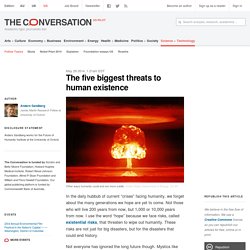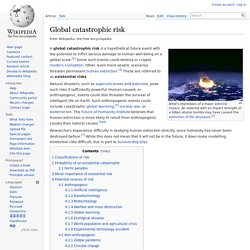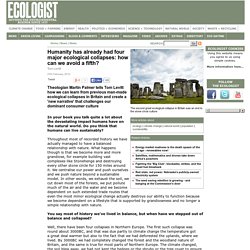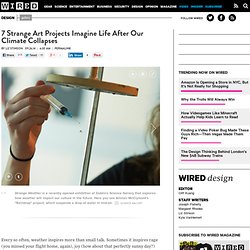

Environmental Humanities Switzerland. About the report · Global Challenges Foundation. This report has, to the best of the authors’ knowledge, created the first list of global risks with impacts that for all practical purposes can be called infinite.

It is also the first structured overview of key events related to such risks and has tried to provide initial rough quantifications for the probabilities of these impacts. With such a focus it may surprise some readers to find that the report’s essential aim is to inspire action and dialogue as well as an increased use of the methodologies used for risk assessment. The real focus is not on the almost unimaginable impacts of the risks the report outlines. Its fundamental purpose is to encourage global collaboration and to use this new category of risk as a driver for innovation.
Scrublands : Antoine Bruy. Collapse dynamics: Phase transitions in complex social systems. World Economic Forum - The Global Risks report 2015. Existential risks: threats to humanity's survival. The five biggest threats to human existence. In the daily hubbub of current “crises” facing humanity, we forget about the many generations we hope are yet to come.

Not those who will live 200 years from now, but 1,000 or 10,000 years from now. I use the word “hope” because we face risks, called existential risks, that threaten to wipe out humanity. These risks are not just for big disasters, but for the disasters that could end history. Not everyone has ignored the long future though. Global catastrophic risk. A global catastrophic risk is a hypothetical future event with the potential to inflict serious damage to human well-being on a global scale.[2] Some such events could destroy or cripple modern civilization.

Other, even more severe, scenarios threaten permanent human extinction.[3] These are referred to as existential risks. Natural disasters, such as supervolcanoes and asteroids, pose such risks if sufficiently powerful. Human-caused, or anthropogenic, events could also threaten the survival of intelligent life on Earth. Such anthropogenic events could include catastrophic global warming,[4] nuclear war, or bioterrorism.
The Future of Humanity Institute believes that human extinction is more likely to result from anthropogenic causes than natural causes.[5][6] Lifeboat Foundation Existential Risk Programs. Human Colony Collapse Disorder: The Top 10 Countdown To Our Own Extinction. Activist Post Misdirected environmentalism continues to paint humanity as the enemy of itself simply through the natural exhalation of carbon dioxide.

Humanity has already had four major ecological collapses: how can we avoid a fifth? In your book you talk quite a lot about the devastating impact humans have on the natural world.

Do you think that humans can live sustainably? Throughout most of recorded history we have actually managed to have a balanced relationship with nature. The Myth of Human Progress and the Collapse of Complex Societies. Why a collapse of global civilization will be avoided: a comment on Ehrlich & Ehrlich. Ehrlich FRS & Ehrlich [1] claim that over-population, over-consumption and the future climate mean that ‘preventing a global collapse of civilization is perhaps the foremost challenge confronting humanity’.

Human civilisation 'will collapse' unless greed culture is stopped, report warns. The think tank found that over the past decade consumption of goods and services had risen by 28 per cent to $30.5 trillion (£19bn) - with the world digging up the equivalent of 112 Empire State Buildings of material every day.

The average American consumes more than his or her weight in products each day, many US two year-olds can recognise the McDonald’s “Golden Archers” sign, although they cannot read the letter, and an average western family spends more on their pet than by someone trying to live in Bangladesh. A cultural shift from consumption to valuing sustainable living was needed because government targets and new technology were not enough to rescue humanity from ecological and social threats. Without action, humans faced problems including changing climates, obesity epidemics, declines in wildlife, loss of agricultural land and more production of hazardous waste. Consumerism it said had “taken root in culture upon culture over the past half-century ... Apocalypse Soon: Has Civilization Passed the Environmental Point of No Return? Remember how Wile E.

Coyote, in his obsessive pursuit of the Road Runner, would fall off a cliff? The hapless predator ran straight out off the edge, stopped in midair as only an animated character could, looked beneath him in an eye-popping moment of truth, and plummeted straight down into a puff of dust. Splat! Four decades ago, a Massachusetts Institute of Technology computer model called World3 warned of such a possible course for human civilization in the 21st century. Nasa-funded study: industrial civilisation headed for 'irreversible collapse'?
A new study partly-sponsored by Nasa's Goddard Space Flight Center has highlighted the prospect that global industrial civilisation could collapse in coming decades due to unsustainable resource exploitation and increasingly unequal wealth distribution.

Noting that warnings of 'collapse' are often seen to be fringe or controversial, the study attempts to make sense of compelling historical data showing that "the process of rise-and-collapse is actually a recurrent cycle found throughout history. " Cases of severe civilisational disruption due to "precipitous collapse - often lasting centuries - have been quite common. " The independent research project is based on a new cross-disciplinary 'Human And Nature DYnamical' (HANDY) model, led by applied mathematician Safa Motesharrei of the US National Science Foundation-supported National Socio-Environmental Synthesis Center, in association with a team of natural and social scientists. The Inevitable Future. Mophie 2015 Game Day Commercial. 7 Strange Art Projects Imagine Life After Our Climate Collapses.
Strange Weather is a recently opened exhibition at Dublin's Science Gallery that explores how weather will impact our culture in the future.

Here you see Alistair McClymont's "Raindrop" project, which suspends a drop of water in mid-air. Science Gallery More than 20 artists explore the idea in different ways. Everyware's "Cloud Pink" allows visitors to touch the fabric cloud. US military begins research into moral, ethical robots, to stave off Skynet-like apocalypse. The US Department of Defense, working with top computer scientists, philosophers, and roboticists from a number of US universities, has finally begun a project that will tackle the tricky topic of moral and ethical robots.
This multidisciplinary project will first try to pin down exactly what human morality is, and then try to devise computer algorithms that will imbue autonomous robots with moral competence — the ability to choose right from wrong. As we move steadily towards a military force that is populated by autonomous robots — mules, foot soldiers, drones — it is becoming increasingly important that we give these machines — these artificial intelligences — the ability to make the right decision.
A Tokyo Design Firm Made Us Artificial Organs for the Post-Apocalypse. Images: takram design engineering. A Pre-Climate Apocalypse Travel Guide. Welcome to Architizer's doomsday cult. We've decided to celebrate the breaking and decay of the West Antarctic Ice Shelf with the breaking of our readers' hearts. Experts predict that sea levels will rise 10 feet in the next few centuries, which means we should probably start to emphasize basic swimming in our educational curriculum, build entire underground communities à la Atlantis, and take a cue from Silicon Valley execs who are quietly investing in floating self-sustainable cities.
Architects are offering their own solutions as well — MVDRV and Morphosis create above-above ground housing, while BIG and OMA build Manhattan's storm barriers. I quit my job to set up a post-apocalyptic commune. In early 2006 I was 39, living in Bristol and working at one of the best robotics labs in the world. I had become increasingly obsessed with what life would be like if civilisation collapsed, and thought that I could find out by setting up a community that acted as if it already had. I created a website called An Experiment In Utopia, and announced that I was creating a novel kind of community based on three main ideas. I wrote: An intentional egalitarian community as a small-scale implementation of postcapitalist, peer production model of economy. Part I : Work as a spontanous, voluntary contribution. In this article, I will present egalitarian communities, mainly Acorn community in Virginia, to examine whether the postcapitalist mode of production in the physical world can be introduced by establishing intentional communities.
The Sociology of Civilizational Collapse. How do we envisage our future? To ask this question usually invites reflections upon personal biography.